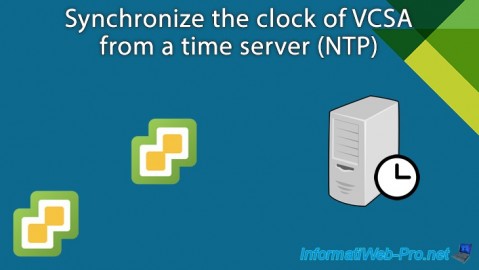Use real (PMem) or simulated (vPMem) persistent memory on VMware vSphere 6.7 via virtual disks
- VMware
- VMware vCenter Server (VCSA), VMware vSphere
- 07 February 2025 at 08:31 UTC
-

- 4/4
9. Data lost
Start your virtual machine.

This time, this virtual machine works again and starts correctly.

However, the "vPMEM" partition created previously in this tutorial will no longer appear in file explorer.

If you right-click "Manage" on "This PC" and go to Disk Management, you will see that an uninitialized disk has appeared.
This matches the disk you just recreated, but obviously the data on the old virtual hard disk will have been lost.

10. Disable simulated persistent memory
If you want to disable simulated "persistent" memory on your VMware ESXi host, you will first need to remove the virtual persistent memory disks (vPMemDisk), as well as any NVDIMMs that allow you to use virtual persistent memory (vPMem). from compatible guest operating systems that you have added to different virtual machines.
To do this, select a virtual machine using persistent memory (PMem) and click on the "Edit Settings" icon.

In this case, we used a SCSI virtual hard disk stored in PMem.
This you can see by the VM storage policy used (Host-local PMem Default Storage Policy) or by looking at its location.
As you can see, the ".vmdk" file of this virtual hard disk is located in a "PMemDS-..." datastore which corresponds to the persistent memory of your host.
Hover over the "Hard disk x" line and click on the cross that appears on the right to remove it.

The message "The device and content will be deleted" will appear.

The desired hard drive has been removed from the VM hardware of this virtual machine.

Once you have removed all the SCSI virtual hard disks stored in a "PMemDS-..." datastore, as well as the NVDIMMs (and their NVDIMM controller) from your virtual machines, all that remains is to disable use of simulated "persistent" memory.
To do this, access the web interface of your VMware ESXi host and go to: Host -> Manage -> System -> Advanced settings.
Next, type "fake" in the search box, select the advanced setting "VMkernel.Boot.fakePMemPct" that appears and click: Edit option.

Specify the value "0" to disable simulated persistent memory usage and click Save.

The message "Successfully changed VMkernel.Boot.fakePMemPct" appears.

Now, make sure the virtual machines present on your host are shut down and restart your VMware ESXi host.
Note: as you can see in the image below, at the moment we have 32 GB of memory (RAM) and 32 GB of persistent memory (PMem).

Confirm restarting your host.

Once your VMware ESXi host has restarted, you will see that you no longer have persistent memory (PMem) and that you have recovered all of the RAM available on your server.

If you view your VMware ESXi host information from the vSphere Client of your VMware vCenter Server (or VCSA), you will see that the "Persistent Memory" line has disappeared from its hardware.

Share this tutorial
To see also
-

VMware 3/8/2024
VMware ESXi 6.7 - Synchronize the clock of VCSA from a time server (NTP)
-

VMware 12/20/2024
VMware vSphere 6.7 - Clone vApps
-

VMware 5/17/2024
VMware vSphere 6.7 - Create and manage tags
-

VMware 12/18/2024
VMware vSphere 6.7 - Export and import vApps

No comment